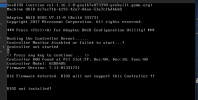Dear Forum,
I'd like to setup a fileserver (plain Debian + SMB +git) on a Proxmox host and I'm wondering what is the recommended approach for doing this in a home lab / mini production environment. The host PC has two HDD RAID 1 Arrays (10 TB each) handled by a hardware RAID controller, which hold all the payload data. Proxmox and the VMs are stored on a separate NVM SSD.
I would like to keep the data separated from the VM as much as possible. The data is backed up elsewhere and I do not necessarily need snapshots of the data drives, however, it would be nice to be able to snapshot the fileserver to save its configuration as well as to do backups of the fileserver VM with PBS (again excluding data).
One option I've thought about is to pass through either the entire RAID controller or the disks to the fileserver VM. My assumption would be that if I remove the controller from the fileserver VM or delete the entire VM, the data would remain unharmed? Are there any other drawbacks except the loss in flexibility?
Another option would be to create Proxmox datastores (e.g. using LVM) on the disks and add those to the VM. However, following this approach, it seems to be quite simple to screw up the data / the disks' LVM configuration by incautiously deleting the fileserver's VM in Proxmox. In addition to that, I'm not hundert percent sure about the implications of using LVM / LVM thin data storages and how this approach scales with an increasing number of snapshots (which in my understanding would necessarily include all data drives as there seems to be be no way of disabling this in Proxmox).
Everything else, such as using ZFS, seems to be out of the picture due to the hardware RAID controller anyway.
I'd also try to avoid all non-standard approaches, which cannot be implemented using the GUI as much as possible.
Any advice on how to set this up properly would be greatly appreciated.
Thanks,
Maxwell
I'd like to setup a fileserver (plain Debian + SMB +git) on a Proxmox host and I'm wondering what is the recommended approach for doing this in a home lab / mini production environment. The host PC has two HDD RAID 1 Arrays (10 TB each) handled by a hardware RAID controller, which hold all the payload data. Proxmox and the VMs are stored on a separate NVM SSD.
I would like to keep the data separated from the VM as much as possible. The data is backed up elsewhere and I do not necessarily need snapshots of the data drives, however, it would be nice to be able to snapshot the fileserver to save its configuration as well as to do backups of the fileserver VM with PBS (again excluding data).
One option I've thought about is to pass through either the entire RAID controller or the disks to the fileserver VM. My assumption would be that if I remove the controller from the fileserver VM or delete the entire VM, the data would remain unharmed? Are there any other drawbacks except the loss in flexibility?
Another option would be to create Proxmox datastores (e.g. using LVM) on the disks and add those to the VM. However, following this approach, it seems to be quite simple to screw up the data / the disks' LVM configuration by incautiously deleting the fileserver's VM in Proxmox. In addition to that, I'm not hundert percent sure about the implications of using LVM / LVM thin data storages and how this approach scales with an increasing number of snapshots (which in my understanding would necessarily include all data drives as there seems to be be no way of disabling this in Proxmox).
Everything else, such as using ZFS, seems to be out of the picture due to the hardware RAID controller anyway.
I'd also try to avoid all non-standard approaches, which cannot be implemented using the GUI as much as possible.
Any advice on how to set this up properly would be greatly appreciated.
Thanks,
Maxwell


